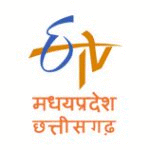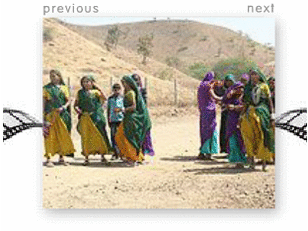| Jhabua Photostory
Bhagoriya is the traditional harvest festival of the Bhil tribe who live mostly in western Uttar Pradesh. It is celebrated with maximum gusto in Jhabua and to a lesser extent in Dhar. Folklore has it that the festival derives its name from a place “Bhagor†in Jhabua district. For long, it has been known for its matchmaking activities which underline the revelry. Also for placating enimities and resolving old disputes – In sum, it is festival of the meeting of hearts. True to its genre, Bhagoriya has colour, sound, taste, smell and touch – in other words, it has something for all the senses. The weeklong festival is held on stipulated days and places labeled as “Haatsâ€Â.
Early in the first half of the day people (esp. young ladies) start getting ready for the occasion. As noon approaches – one can see groups (esp. of the young ones) walking towards the site. In most cases one would see the groups of a particular village wearing the same colour scheme – to mark their collective identity and solidarity. Interestingly, black is the colour of choice (which is considered inauspicious among the caste Hindus).
More often than not plain (without any patterns) basic colours are used. Once at the site, greetings are exchanged and a general reconnaissance of the area is done (It could well be a way of shortlisting the potential beaus). All this while the respective groups arrive accompanied by drums of all sizes and shapes playing on a rhythmic slow beat whereas the pride of place is given to the Maandal – the huge drum played by an expert at the centre of the proceedings. Often, colourfully decked flutes accompany it. The dancers include both men and women – many a time a young beautiful lady holds centrestage. Music at Bhagoriya is rhythmic and without a change in the beat and so is the dance which is limited to a few steps with circular movement being the preferred mode. Interestingly, there is little singing involved, if at all (Ocassionally. Smell of Mahua pervades the air and the whiff of spicy snacks overtakes the senses – The local toddy flows freely with Bhajiyas (traditional fried chilly snacks). Trees of Amaltas, Palash and Semal lend colour to the environment. In particular, palash whose petals are used for making colour.
By mid day- drumbeats rise; dancing is faster, louder shouting
In between a young lad offers betel, tries to apply colour
As everything else in Indian society, its traditional elements jostle with the modern variants. The unfortunate fallout is the more famous ones have lost their charm – zing remains only in those the interior areas sot drinks, giant wheels, googles even traditional jewellry (esp. among men) defensive about, seen as market (with trinkets – only fresh produce, coming by buses; polyester, tacky make up occasional Aggresive love and trend has undergone a tremendous change over the years.
Bhagoriya; occasionally a bureaucrat visits and an odd poitical flag too. The policemen on watch can barely make any sense of the fuss.
As dusk approaches – beat crescendo, dancing frenzied. Those who’ve found mates. The ones who’ve been unsuccessful try and live it up and a third category of pure fun seekers slowly and gradually the crowds start dispersing – groups retracing their paths – mostly walking but also in over crowded jeeps
what makes it different
Change is a way of life but for traditions unchanging continuity is the spirit. Camera and outsider should not be allowed – (as was the norm earlier )- change with continuity do not want museum specimens.
It is incumbent upon us to maintain its pristine form – since it is a living record of a particular way of life. Turning it into a spectacle or an oddity would mean losing its spirit for ever. Towards the end
at sunset, it is as if nothing ever happened there – only memeories remain to return next year .
Mass Swayamvara; settle scores with adversaries
The merriment is dedicated to the worship of Bahgoradav(God of dance) and is held one week before the festival of color, Holi. This very popular tribal festival highlights the love, romance and marriage among the tribal folks.
According to the rituals of the festival, Bhil youths indulge themselves in meeting their future spouse. Unmarried men go around, applying color to his loved ones and if the girl reciprocates her sentiment, she applies color in return. Also the mutual exchange of betel leaf declares the loving environment. After this ritualistic permission, both the lovers are allowed to elope into some alien land so as to spend moments together. The marriage then get eventually salmonized and a warm welcome is presented to the newly wed couples
|


 'SPECIAL DEFUNCT SESSION' : Political parties are supposed to have a vision about the state before the elections, particularly in their second innings. Thus summoning a special session one year...
'SPECIAL DEFUNCT SESSION' : Political parties are supposed to have a vision about the state before the elections, particularly in their second innings. Thus summoning a special session one year... I’M HALF A ANNA [October, 2011] : The recent agitations by an ex-armyman turned tele–Gandhi(an) and a celebrity yoga guru has exposed the limitations of the Indian state and pushed the limits of its middle class ...
I’M HALF A ANNA [October, 2011] : The recent agitations by an ex-armyman turned tele–Gandhi(an) and a celebrity yoga guru has exposed the limitations of the Indian state and pushed the limits of its middle class ...

 Literature and Cricket to connect at DSC Jaipur Literature Festival 2013 : The DSC Jaipur Literature Festival, Asia’s leading literature event, scheduled to begin in the Rajasthan capital from January 24th...
Literature and Cricket to connect at DSC Jaipur Literature Festival 2013 : The DSC Jaipur Literature Festival, Asia’s leading literature event, scheduled to begin in the Rajasthan capital from January 24th... MULTIPLEX LITERATURE : Hyped as the world’s greatest literary “ show ” , the Jaipur Lit fest had big ticket authors , A-list celebrities , eclectic food & fashion-all the makings of a multiplex experience...
MULTIPLEX LITERATURE : Hyped as the world’s greatest literary “ show ” , the Jaipur Lit fest had big ticket authors , A-list celebrities , eclectic food & fashion-all the makings of a multiplex experience...

 PUBLIC COMMUNICATION IN SCIENCE – SCOPE AND LIMITATIONS : “It is suicidal to have a society dependent upon science & technology where masses are not aware of the developments of science.”
PUBLIC COMMUNICATION IN SCIENCE – SCOPE AND LIMITATIONS : “It is suicidal to have a society dependent upon science & technology where masses are not aware of the developments of science.” SHORT CIRCUITED PARIKRAMA : When the idea of International River festival was mooted over two years ago, it filled a longstanding void , particularly in the context of Narmada...
SHORT CIRCUITED PARIKRAMA : When the idea of International River festival was mooted over two years ago, it filled a longstanding void , particularly in the context of Narmada...

 दम तोड़ती जाबाली योजना : भोपाल | 19 साल पहले बने मध्यप्रदेश सरकार की जाबाली योजना आज दम टूटने के कगार पर खड़ी है | देह व्यापार को मजबूर बाछड़ा जाती के लिए बने इस योजना के अंतर्गत प्रदेश के केवल 650 को ही यह लाभ...
दम तोड़ती जाबाली योजना : भोपाल | 19 साल पहले बने मध्यप्रदेश सरकार की जाबाली योजना आज दम टूटने के कगार पर खड़ी है | देह व्यापार को मजबूर बाछड़ा जाती के लिए बने इस योजना के अंतर्गत प्रदेश के केवल 650 को ही यह लाभ... धुन के पक्के हैं ये बच्चे : भोपाल | शिल्पा, हेमा, अजीत की तरह श्रद्धा, नेहा, पूजा जैसी सैंकड़ो बालक-बालिकाएं है, जो जुडो, कबड्डी, खो-खो, वेटलिफ्टिंग और कराटे में अपना भविष्य तलाश रहे हैं | ये सभी देह व्यापार में लिप्त रही महिलाओं...
धुन के पक्के हैं ये बच्चे : भोपाल | शिल्पा, हेमा, अजीत की तरह श्रद्धा, नेहा, पूजा जैसी सैंकड़ो बालक-बालिकाएं है, जो जुडो, कबड्डी, खो-खो, वेटलिफ्टिंग और कराटे में अपना भविष्य तलाश रहे हैं | ये सभी देह व्यापार में लिप्त रही महिलाओं...





 Facebook
Facebook LinkedIn
LinkedIn Twitter
Twitter Bhopal Masterplan
Bhopal Masterplan MP Elections
MP Elections


















 Follow us on
Follow us on

 Events
and individuals overlooked by the Mainstream media ; processes and policies glossed
over by Alternative media; compilation and aggregation of Madhya pradesh's mediaspace
; links to key sections of relevant sites.
Events
and individuals overlooked by the Mainstream media ; processes and policies glossed
over by Alternative media; compilation and aggregation of Madhya pradesh's mediaspace
; links to key sections of relevant sites. Archive Section - Here you can find Articles published in yester years
Archive Section - Here you can find Articles published in yester years